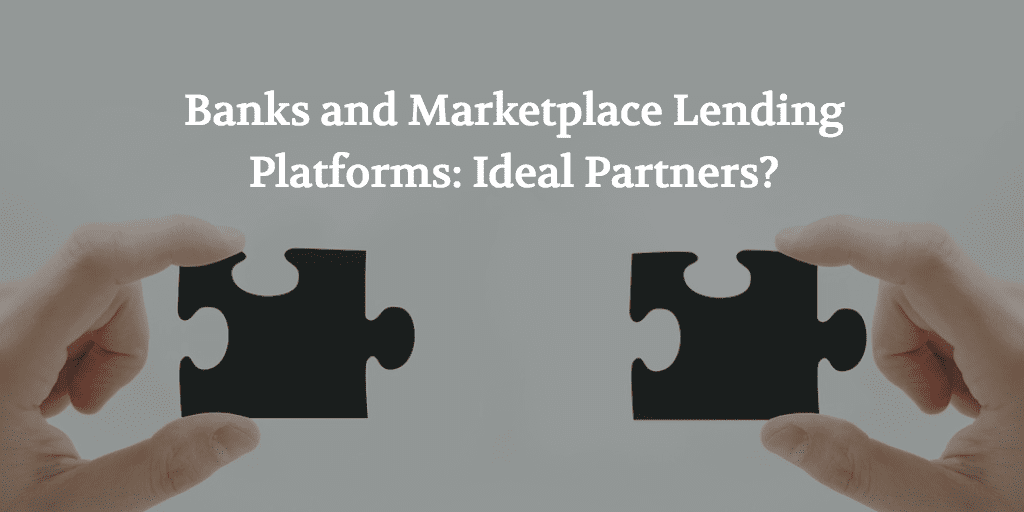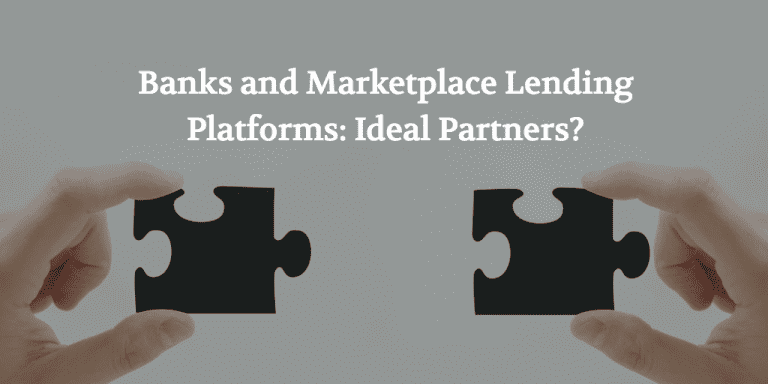
Bank partnerships are nothing new when it comes to the marketplace lending industry. As the industry has continued to mature we’ve seen an increase of these partnerships and, despite recent challenges, we will undoubtedly see more in the near future. As we’ll outline below, some of the partnerships have to do with renting a partner bank that has become a common strategy for marketplace lenders.
Other banks are looking to form a deeper relationship with online lenders to better serve their existing customers. To this end banks have three options: build, buy or partner. While we haven’t yet seen a bank buy a marketplace lending platform, both Wells Fargo and Goldman Sachs have built or are in the process of building out their online lending platforms.
Finally, some banks are also investing in loans directly for the yield. For Lending Club and other marketplace lenders banks have been a sizable source of capital. However, following the news surrounding the departure of the former CEO of Lending Club Renaud Laplanche many banks pulled back. We saw firsthand that of all types of investors banks are the slowest to move due to lengthy due diligence processes. While the initial shock certainly affected Lending Club and perhaps other marketplace lenders Lending Club has made some progress in bringing banks back into the fold.
Below are is a rundown of some of the significant bank partnerships in the marketplace lending industry.
Marketplace Lenders and the Rent a Partner Bank Model
One of the most important way marketplace lenders partner with banks is through an origination partner. An example of this is Lending Club and Prosper’s partnership with WebBank, a Utah based chartered industrial bank. Under this model the loans are first originated by Web Bank and sold back to Lending Club or Prosper after a short amount of time. There are many advantages to this model for the marketplace lender but the end result is that all loans issued in this model must adhere to all federal banking laws.
A slightly different take on this model is the partnership between Marlette and Cross River Bank, another partner bank similar to WebBank. With this partnership Marlette and Cross River Bank completed a $100 million securitization in which both companies shared a 12.5% equity tranche. Cross River Bank are strong believers in having “skin in the game” so they keep a piece of every loan they issue in that relationship. They also work with many other marketplace lending platforms.
OnDeck and JP Morgan Chase
The biggest announcement to date when it comes to bank partnerships is where JP Morgan Chase is partnering with small business lender OnDeck. The partnership between JP Morgan and OnDeck is a massive opportunity. JP Morgan boasts 4 million small businesses and OnDeck has the technology and infrastructure to underwrite them. The platform launched on a limited basis in April, 2016 and while there hasn’t been any news since then I’d expect we will hear an update on the progress shortly.
Kabbage and Santander, ING and ScotiaBank
Santander UK announced in April 2016 their partnership with US based small business lender Kabbage. For Santander’s small business customers the partnership gives them quicker access to credit. For Kabbage this was not only significant due to Santander being a well known bank, but it also marked their entrance into the UK market. Other partnerships that Kabbage has entered into include their partnership with ING to initially extend credit to ING customers in Spain and a partnership with ScotiaBank to do the same in Mexico and Canada.
Avant and Regions Bank
In April, 2016 Avant struck a partnership with Regions Bank, a top 20 bank in the US. Regions Bank is leveraging Avant’s platform to offer unsecured loans to their current customers. The bank currently has $126 million in assets with around 1,600 bank branches. Regions Bank will make the loan to the end borrower and simply pays Avant a fee for using their technology platform. While some believe online lenders are competing directly with traditional banks, this partnership is a perfect example of how a bank can leverage a solution that already exists and offer their current customers a better experience.
Fundation and Regions Bank
Regions Bank’s entrance into online lending first started with small business lending. Regions Bank entered into a partnership with small business lender Fundation in October 2015. The new offering allows small businesses to apply for a loan online through Fundation, but also allows borrowers to elect to have a Regions banker call to complete the application. Depending on the loan type and amount, it will either be underwritten by Fundation or by Regions itself. The result is a co-branded site with Regions and the loan being “Powered By Fundation.” At the time of announcement Sam Graziano, CEO of Fundation was quoted in USA Today stating they expect the partnership will at least double originations and revenue.
Lending Club and Union Bank
Back in May, 2014 Lending Club announced their partnership with Union Bank. This partnership included the creation of new products for Union Bank customers. In addition Union Bank agreed to purchase personal loans on Lending Club’s platform. We don’t know the current status of this partnership but it was a groundbreaking announcement at the time.
Lending Club and BancAlliance
Lending Club announced a partnership with BancAlliance in February, 2015. BancAlliance is a consortium of 200 community banks that have assets ranging from $200 million to $10 billion. These banks are able to invest directly in Lending Club loans and also send borrowers looking for loans directly to Lending Club. For the smaller community banks this partnership is a perfect example of how they can serve customers that they can not or choose not to underwrite themselves.
Prosper and Radius Bank
In September, 2015 Prosper announced a partnership with Radius Bank. Radius Bank describes itself as a bank that provides personalized attention only a community bank can provide, with a commitment to adopting the most advanced and secure technologies. With this partnership Radius Bank now offers consumer loans directly through Prosper’s platform.
Conclusion
As lending moves online it is important for every bank to have an online lending strategy. Getting a loan online is something that some consumers are now getting accustomed to, but it is eventually going to be something they expect from every bank. The consumer of tomorrow simply will not be willing to visit a bank branch and fill out loan paperwork. Not only that but banks can benefit by offering new products for their existing customers through partnerships with online lending platforms.
What is in it for marketplace lenders? Most importantly, banks can be a major source of capital. Banks also have large customer databases and can help marketplace lenders access a new set of customers. This true win-win is the reason we’ve seen so many banks go the partnership route and why this trend will likely continue.


